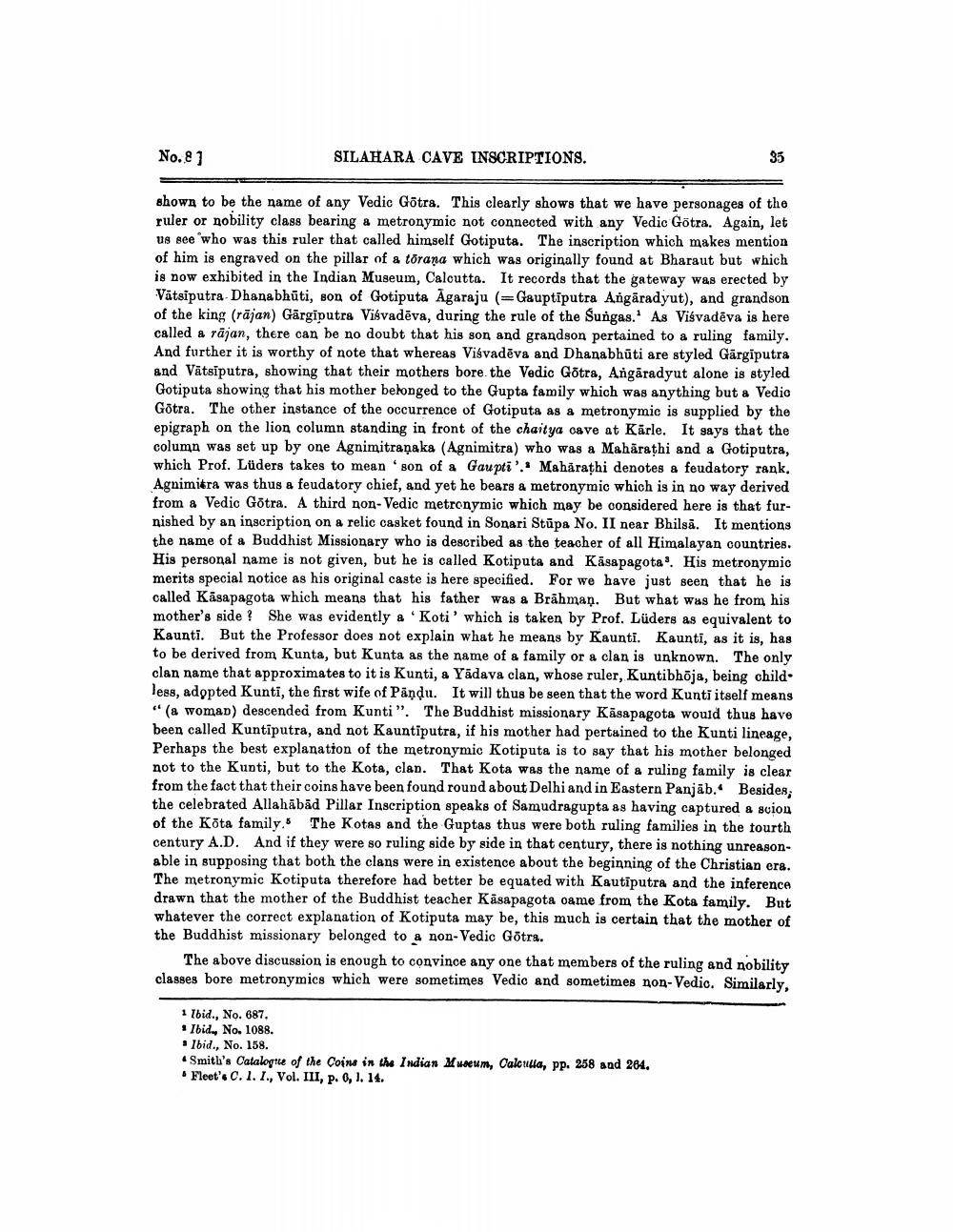________________
No. & 1
SILAHARA CAVE INSCRIPTIONS.
shown to be the name of any Vedic Götra. This clearly shows that we have personages of the ruler or nobility class bearing a metronymic not connected with any Vedic Götra. Again, let us see who was this ruler that called himself Gotiputa. The inscription which makes mention of him is engraved on the pillar of a torana which was originally found at Bharaut but which is now exhibited in the Indian Museum, Calcutta. It records that the gateway was erected by Vätsiputra Dhanabhūti, son of Gotiputa Āgaraju (=Gauptīputra Angāradyut), and grandson of the king (räjan) Gärgiputra Visvadēva, during the rule of the Sungas.' As Visvadēva is here called a rājan, there can be no doubt that his son and grandson pertained to a ruling family. And further it is worthy of note that whereas Visvadēva and Dhanabhūti are styled Gärgiputra and Vätsiputra, showing that their mothers bore the Vedic Gotra, Angāradyut alone is styled Gotiputa showing that his mother belonged to the Gupta family which was anything but a Vedic Götra. The other instance of the occurrence of Gotiputa as a metronymic is supplied by the epigraph on the lion column standing in front of the chaitya cave at Kärle. It says that the column was set up by one Agnimitranaka (Agnimitra) who was a Mahärathi and a Gotiputra, which Prof. Lüders takes to mean son of a Gaupti'. Mahārathi denotes a feudatory rank. Agnimitra was thus a feudatory chief, and yet he bears a metronymic which is in no way derived from a Vedic Götra. A third non-Vedic metronymic which may be considered here is that furnished by an inscription on a relic casket found in Sonari Stūpa No. II near Bhilsa. It mentions the name of a Buddhist Missionary who is described as the teacher of all Himalayan countries. His personal name is not given, but he is called Kotiputa and Käsapagota'. His metronymic merits special notice as his original caste is here specified. For we have just seen that he is called Kāsapagota which means that his father was a Brāhmaṇ. But what was he from his mother's side? She was evidently a 'Koti' which is taken by Prof. Lüders as equivalent to Kaunti. But the Professor does not explain what he means by Kaunti. Kaunti, as it is, has to be derived from Kunta, but Kunta as the name of a family or a clan is unknown. The only clan name that approximates to it is Kunti, a Yadava clan, whose ruler, Kuntibhöja, being child. less, adopted Kunti, the first wife of Pandu. It will thus be seen that the word Kunti itself means "(a womad) descended from Kunti”. The Buddhist missionary Kāsapagota would thus have been called Kuntiputra, and not Kauntiputra, if his mother had pertained to the Kunti lineage, Perhaps the best explanation of the metronymic Kotiputa is to say that his mother belonged not to the Kunti, but to the Kota, clan. That Kota was the name of a ruling family is clear from the fact that their coins have been found round about Delhi and in Eastern Panjab. Besides, the celebrated Allahābād Pillar Inscription speaks of Samudragupta as having captured & scion of the Köta family. The Kotas and the Guptas thus were both ruling families in the fourth century A.D. And if they were so ruling side by side in that century, there is nothing unreasonable in supposing that both the clans were in existence about the beginning of the Christian era. The metronymic Kotiputa therefore had better be equated with Kautiputra and the inference drawn that the mother of the Buddhist teacher Käsapagota oame from the Kota family. But whatever the correct explanation of Kotiputa may be, this much is certain that the mother of the Buddhist missionary belonged to a non-Vedic Götra.
The above discussion is enough to convince any one that members of the ruling and nobility classes bore metronymics which were sometimes Vedic and sometimes non-Vedio. Similarly,
1 Ibid., No. 687. • Ibid., No. 1088. • Ibid., No. 158. 4 Smith's Catalogte of the Coins in the Indian M
Fleet's 0.1. I., Vol. III, p.0,1. 14.
em, Calcudia, pp. 258 and 264.




